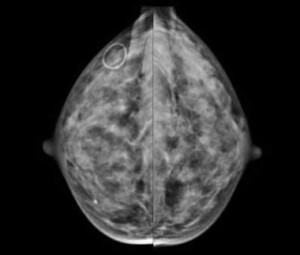Screening ultrasound detects more cancers in women with dense breasts, study
by
Loren Bonner, DOTmed News Online Editor | April 19, 2013

An extreme case of breast density
(Credit: RSNA)
The topic of dense breast tissue has been discussed heavily in medical circles, and how to detect lesions in women with dense breast tissue has been even more debatable. A new study presented this week at the American Roentgen Ray Society's annual meeting in Washington, DC finds that ultrasound screening performed after mammography on women with dense breast tissue is capable of detecting more lesions.
Although it's still debatable how doctors should define dense breast tissue, this study screened women with greater than 50 percent breast density. Screening ultrasound was able to detect an additional 3.4 cancers or high-risk lesions per 1000 women screened, a detection rate just under that of screening mammography alone for women with less dense breasts, according to the study.
On a mammogram, dense breasts have less fat and more connective tissue, which appears white on the mammogram, just like cancer, possibly making it easy for radiologists to miss.
The study, conducted over two years and in conjunction with seven Connecticut radiology practices, included 19,745 women who had dense breasts and "normal" mammograms. According to Dr. Sarah Steenbergen from Yale University and lead author of the study, 67 cancers were found. She also noted that sensitivity of screening breast ultrasound increased from 96.6 percent to 100 percent and in specificity from 94 percent to 96 percent over the two year period.
"We anticipate that as the number of screening breast ultrasounds increase, physicians will be even better able to differentiate benign from malignant lesions," she said.
Connecticut was the first state to pass legislation in 2009 that requires doctors to inform women of their breast density and possible risks following a mammogram, as well as the types of screening options available to them. Similar laws have been passed in Texas, Virginia, California and New York in more recent years.
Steenbergen said this study was conducted, in part, to measure the outcome of this legislation and how screening breast ultrasound can be an effective screening tool.
Several studies have already looked at adding ultrasound to mammography to detect lesions in women with dense breast tissue. One of the most well-known, called the American College of Radiology Imaging Network's 6666 Breast Cancer Study, showed that ultrasound with mammography found an additional 1.1 to 7.2 cancers per 1000 high-risk women with dense breast tissue.
|
|
|
You Must Be Logged In To Post A Comment
|
